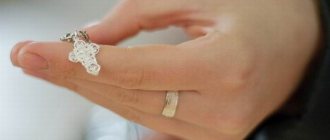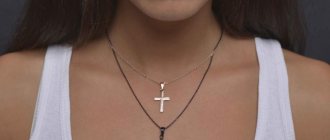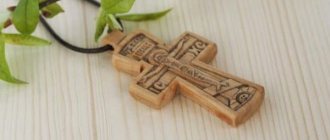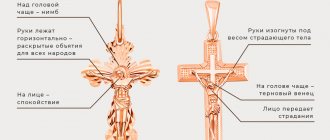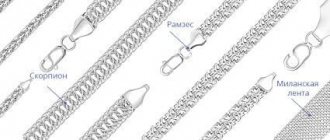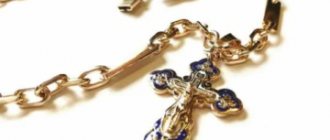1:502 1:507
The cross is an indicator of belonging to the Christian faith. From this article you will find out whether it is possible to wear someone else’s cross, and why it cannot be worn over clothes.
1:800
The cross, according to the clergy, should always be on a believer. But there are also prohibitions associated with it. Some of them are nothing more than superstitions that a believer should not even think about. These include, for example, the darkening of the cross. But this is far from the only question that a believer may have about his cross.
1:1487 1:1492 1:1552
2:503 2:508
You cannot wear an unconsecrated cross
It is best to consecrate the cross. But as such, there is no prohibition on wearing an unconsecrated cross. It is believed that evil spirits avoid even two crossed sticks. Nevertheless, a believer should still consecrate his symbol of faith. You can choose any cross you like: gold, silver, copper or wood. The material is not very important. It is important to consecrate it and not wear jewelry purchased at a jewelry store as a cross. It is necessary to understand that the church Orthodox cross, which symbolizes faith in God, differs from beautiful, but purely decorative crosses. They do not carry a spiritual load and have nothing to do with faith.
2:1323 2:1328 2:1398
3:1902 3:4
Why should I go to church if I have faith in my soul? Why wear a cross if I’m already a Christian? Is it really written in the Gospel that everyone should wear crosses? So to wear or not to wear? Similar questions are often asked by unchurched people.
3:464
Let's try to answer.
3:505 3:510
Orthodox and Catholic cross
It is from the 17th century that the difference between Orthodox and Catholic crosses originates. If Catholics focused on suffering, then Orthodox Christians focused on the coming victory and resurrection of the Savior. And today, when thinking about how to choose a pectoral cross, it is considered natural to choose the Orthodox symbol of the Christian faith.
- Orthodox cross:
- usually six-pointed or eight-pointed;
- above the head of Christ you can find an upper crossbar and a “tablet” with the letters I.N.Ts.I (there are also variants I.N.Ts.I., INRI, which translates as “Jesus of Nazareth, King of the Jews”);
- the hands of the Savior are placed on the central crossbar;
- Christ's legs are not crossed, but lie parallel;
- under your feet there is an oblique crossbar;
- on the back it says “Save and Preserve.”
- more laconic design;
- two crossbars (not three!);
- an image of Christ with sagging arms and an emphasis on the torment of the Savior;
- legs crossed.
Which form should I choose?
The eight-pointed cross is considered the most traditional in Orthodoxy. But this form is far from the only one. Therefore, if you like another option, do not deny yourself the pleasure of wearing exactly the cross that you want.
- The eight-pointed cross is a symbol on which there are three horizontal lines: a central crossbar for the arms, a lower crossbar for the legs, and a plate above the head of Christ.
- The six-pointed cross is the second most common symbol, which does not have a plate on top, and the bottom crossbar is located diagonally.
- A four-pointed cross (also called teardrop-shaped) - at the ends of such a cross there are “drops”, symbolizing the drops of blood shed by Christ.
- Trefoil is a lush decoration that has semicircular leaves and beads in the form of small “bumps”.
- The Latin cross is a very ancient Western European symbol. This cross is very simple (it is only two crossbars), but its lower part is much longer than the upper. It symbolizes the long suffering of Christ, who endured torment for a very long time in the name of the redemption of mankind.
Where did this tradition come from?
Wearing a cross without a real Christian life will look like some kind of fake. Treating the cross as a beautiful decoration will also serve to condemn a person. So what happens: you can’t wear it, otherwise you’ll harm yourself?
3:1016
Wearing a pectoral cross is not only possible, but also necessary. Many believers can confirm: this is the most powerful protection for a person. Why? Because the cross is the instrument of Christ's death. The crucified Jesus washed away the sins of every person with His Blood.
3:1440
Therefore, this reminds every Christian of the sacrifices God makes for man, for which Christ suffered. If Jesus had not suffered, the people would have had no hope of salvation. The cross is rightly called the instrument of our salvation. But many people refuse to wear this item on their body.
3:1985
Among the arguments, the most popular are:
3:77
- this in no way confirms that I am a Christian;
- There are no indications in the Gospel about wearing a cross; the first Christians did not know this either...
Yes, indeed, wearing a cross on a pectoral cross without practicing Christian life is reminiscent of a person trying to sail on a wreck of a ship in a storm.
3:603
Indeed, the Gospel and the lives of the early Christians do not indicate that people supported modern practices.
3:809
But in the life of the early church there was a custom of wearing medallions with the image of the slain Lamb or the Crucifixion. Sources from the 2nd century indicate: some Christians already had crosses or painted them on their foreheads in order to “give themselves away” to their persecutors and suffer for their faith. When the “hunt” for believers subsided, the pious example of the early Christians spread widely.
3:1446
An interesting historical fact is given by Archpriest Igor Fomin.
3:1564
There was one rather humiliating custom in the Roman Empire. Just as we now put a collar on dogs, their slaves wore the same straps around their necks indicating the name of their owner.
3:324
The first Christians, opposing themselves to such a society, wore crosses, as if saying: we do not belong to you. We have another Master who paid for us with his own life.
3:676 3:681
How to choose a pectoral cross as a gift
Of course, a crucifix is a very personal accessory. However, you should not worry about whether a cross can be given as a gift or whether a person must buy it himself. The custom of giving a pectoral cross is wonderful. He talks about the good feelings of the donor, about the desire to protect his loved one from failures and problems. That’s why, for example, children’s pectoral crosses are so often chosen as a gift.
It is believed that the reason for such a special gift can be considered:
- Christening;
- Day Angel;
- Easter;
- Christmas;
- other Orthodox holidays.
Moreover, we are talking specifically about a Christian symbol, and not about a decorative cross. The latter do not have any inscriptions or symbols on them; they do not have the figure of the Savior or the words “Save and Preserve.” Such jewelry can be given as jewelry accessories for any occasion. They go with any style, any wardrobe.
By the way, there is practically no difference between men's and women's crosses. Traditionally, men's crosses are a little more massive and laconic, while women's crosses can be more elegant and smaller. In addition, for representatives of the fair half of humanity, crosses inlaid with precious inserts are often chosen. In general, when choosing, it is better to focus solely on your own preferences.
Christening gift
If you have been chosen as a godmother or father, one of your first duties is to present the main article of faith to your future godson. How to choose a cross for a child's baptism? This is not an easy question. You need to decide:
- whether to purchase a product made of gold or silver;
- what color to choose;
- Is it necessary to give an additional chain?
Neither the church nor customs give strict advice here. It can be a gold or silver cross, smooth or with precious inserts, on a chain or on a string - it all depends on you. But it still makes sense to adhere to some recommendations.
- It is best to purchase jewelry made of gold or silver. These precious metals are hypoallergenic and therefore will be completely safe for the baby.
- When choosing a cross, pay attention to its shape and weight. Avoid sharp corners and limit the length to a maximum of 2 cm. Keep it simple and light decoration.
- It makes sense to choose not a precious chain for the sacrament of baptism, but a cord made of silicone, silk or leather. It is more durable than a chain and will not rub the baby's delicate neck.
- Check that the hole where the lace is threaded is large enough (so that the lace and the future chain can fit into it accurately).
- If you also give a chain along with a cross, then stick to the basic weaving options. Let it be armored or anchor technology. Fancy chains do not go very harmoniously with any crosses on the body.
Spiritual protection
4:1221 4:1226
Today it is customary to put a cross on a person after performing the Sacrament of Baptism. This is a confirmation of my involvement in the Church and the understanding that the Son of God suffered for my sake.
4:1548 4:4
- Yes, all this is nonsense! Why wear a cross? - the skeptic will say. — Just think: two wooden sticks or a metal figurine. Can they protect a person?
4:290
The answer is very laconic: they can. A lot of evidence can be found.
4:407
For example, during difficult Soviet times, it was forbidden to wear “metal figures.” If a girl is going to marry a man of other faiths, she is usually required to remove... her cross. It goes something like this: renounce your faith, turn away from Christ.
4:856
And how many stories there are about how, without a cross, people were deprived of spiritual protection! Many became possessed - they were possessed by evil spirits. And when someone approached them with a cross, they began to cower, scream, curse, and bang their heads against the wall...
4:1326 4:1331
Gold or silver?
Church ministers do not distinguish between crosses, no matter what material they are made of. But you must admit that a wooden cross or a talisman made of a non-precious alloy is not a very durable option. The wood swells, and the alloys darken and can even cause allergies. Taking into account the fact that ideally a pectoral cross is a person’s companion for life, it is better to choose a crucifix made of one of the precious metals. The traditional favorites here are gold and silver. And this is understandable. Such crosses:
- will not cause allergic reactions upon contact with skin;
- absolutely safe for babies;
- durable, without losing their aesthetic appearance;
- Easily combined with other decorations.
But which of the two metals should be preferred?
Gold
The most precious metal, a symbol of luxury and wealth. Of course, buying a gold cross to show off your financial status is not the best idea. But it is very possible to express respect and reverence for the symbol of faith in this way. In addition, it is believed that gold is an attribute of royal power, and Christ is recognized by believers as the king of the visible and invisible world.
Silver
Traditional “number 2” on the precious list, silver serves as an excellent material for pectoral crosses. The fact is that modesty is valued in Orthodoxy, and gold can be viewed as an overly luxurious material, in which external chic can overshadow the true content. Silver is simpler, cheaper, more modest - that’s why many people prefer it.
By the way, it is believed that it is better to present a silver cross to a baby for baptism - from a practical point of view. Gold can get lost, break, etc. Silver is better: it is more democratic, and buying a new cross will not be difficult. In addition, silver has bactericidal properties.
Don't be afraid that the silver will darken. Today, most jewelry is coated with a layer of rhodium, and it perfectly protects the lunar metal from oxidation. The optimal solution would be to buy a silver cross for daily wear, and if you really want a gold one, put it aside as a reserve for growth.
The attitude of the church towards body icons
Body icons are considered the most important attribute of the Christian faith. They must accompany a believer throughout his life. It is necessary to put such icons on people from infancy. This amulet will protect him from evil and committing bad deeds. They cannot be removed unless absolutely necessary, since without them a person will remain unprotected.
Most body icons depict images of saints. They are of great importance for every person who sincerely believes in God. You can read about the first body icon in the Bible. It describes one incident from the life of Christ when he healed a sick person with the help of such a sacred image. It was after this incident that Christ’s commandment about icon veneration appeared. Such small body images are no less significant than ordinary icons. They are revered in the Christian church in the same way as wall images of saints.
What types of amulets and talismans are there and how to wear them?
Let's start with the most important thing - with definitions. Often the words “talisman”, “amulet” and “amulet” are considered synonymous, but this is the wrong approach. The shades of meaning here are quite significant.
So, a talisman (from the ancient Greek τέλεσμα “dedication, enchantment”) is a magical object, the function of which is to attract the desired forces and situations to the wearer. Thus, the talisman can be used to attract good luck, love, increase financial well-being, attractiveness, and so on. In the language of computer games: “+10 to charisma, +100 to health.” So, we can say that Pushkin in his lines “Keep me safe, my talisman...” sacrificed meaning for the sake of rhyme and meter.
How to wear a talisman correctly: since a talisman usually does not have a protective function, it is better to hide it from prying eyes, wear it close to the body, or simply have it with you, wrapped in a suitable fabric. However, each talisman must be dealt with separately - often talismans contain elements of an amulet, i.e. protection, which we will discuss in more detail below. For example, images of crosses, solar symbols, pentagrams as part or basis of a talisman will protect it from the negative attention of others. The talisman stone can also be worn in plain sight, because... natural minerals have natural protection. The same applies to the talisman ring - the ring is based on a hoop, a protective circle, a symbol of the wheel of life. It’s better to pin the talisman on a pin to the inside of the clothes so that it is not visible.
An amulet (from the Latin amulētum) is a magical item designed to reduce or ward off the impact of unwanted factors and forces from the wearer. An amulet can protect on the go, protect against damage and the evil eye. It can also bring good luck. But the difference is that a talisman acts as a magnet for good luck, attracting it, while an amulet prevents anything from happening that will ruin your plans. Thus, the result may be the same, but on a subtle level the mechanics of the process will be different.
How to wear an amulet correctly: since it performs a protective function, it does not really matter whether it is visible to others. It can be worn secretly (for example, a Christian pectoral cross - its name already contains a hint as to where this, essentially an amulet, belongs - on the body). Can also be worn for show, over clothing. This could be a ring, earrings, a pendant - these are often worn on a red thread on the hand, like a bracelet. Actually, the red thread can also be an amulet.
The word “amulet” comes from the Russian verb “to protect”, and its purpose is similar to that of an amulet. It protects against the evil eye, negativity and evil. However, a talisman can be not only a personal item worn on the body or with oneself. The amulet can be used to protect a house, car or other property, and can be located at the threshold, in the kitchen of the house, or hanging under the mirror in the car (doll, magic bag, etc.). Also, the protective function can be performed not by a separate item, but, for example, by embroidery on clothing - remember the clothes worn by the ancient Slavs, where each element had its own meaning and purpose.
How to wear a talisman correctly: basically, amulets that are of a personal nature and do not belong to the home are worn for show, in a visible place. In traditional culture, the amulet was an integral part of clothing and image - embroidery, jewelry, entire items of clothing (such as a belt). Charms were worn close to important and vulnerable places on the body - as they were seen in the popular consciousness. Such places were the areas around the face (headdresses, earrings), chest (necklaces, pendants), the belt area and below the belt (belt, buckles), wrists (bracelets or embroidered sleeves). Also, amulets were worn at the back, on the back - against the evil eye and words thrown at the back. Today, this function of back protection can be performed, for example, by badges and key rings on a backpack.
All types of these magical items can be both artifacts, i.e. objects created by man (and not even necessarily from the very beginning with a magical purpose - for example, a horseshoe), and objects of natural origin. The latter include, for example, natural crystals and druses of stones, animal parts (for example, fangs or feathers), herbs and plant branches and other gifts of nature.
